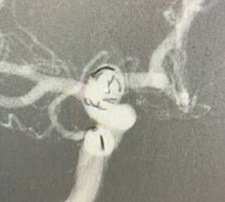
Arissa Medical has announced the enrolment of the first patients in its Syntra study—a first-in-human (FIH), early feasibility study evaluating the safety and efficacy of the company’s Syntra device for the treatment of wide-necked sidewall and wide-necked bifurcation cerebral aneurysms.
Initial cases in the study were successfully performed at Instituto de Neurocirugía Dr Alfonso Asenjo in Santiago, Chile by interventional neuroradiology (INR) principal investigator Juan Gabriel Sordo (Clínica Santa María, Santiago, Chile).
The Syntra device is a novel scaffold endoskeleton frame structure designed to facilitate enhanced intrasaccular neck coverage, reducing neck diameter, and enabling improved adjunctive coiling, to achieve optimal packing density and volume for intrasaccular blood flow-attenuated embolisation treatment in cerebral aneurysm cases. Arissa claims that, because Syntra is a purely intrasaccular device, the use of dual antiplatelet medication alongside it is not necessary.
According to the company, Gary Duckwiler (University of California Los Angeles [UCLA] Medical Center, Los Angeles, USA) and Luis Augusto Lemme (Buenos Aires, Argentina) contributed significantly to preclinical evaluations of the device by providing a “roadmap” to ensure the necessary requirements for achieving safety and efficacy were fulfilled.
Another significant benefit of this device, in addition to the elimination of multiple antiplatelet therapies, is its deliverability, Arissa further notes. The device is designed to “easily” navigate through tortuous vessels via a flexible, monolithic intra-aneurysmal implant for facilitating delivery, retraction, and placement, as well as the ability to negotiate acute angulation of the aneurysm from the parent vessel—enabling the treatment of challenging aneurysms.
“Initial control of the neck of a wide-necked aneurysm is critical to stable and safe aneurysm treatment, and the Syntra is designed expressly for this purpose,” said Duckwiler. “Practitioners familiar with aneurysm coiling will find the transition to using Syntra to be simple. These characteristics—as well as the safety and effectiveness of the device—will need to be fully examined, but the results from this initial cohort are promising.”
Arissa’s hope is that the Syntra device can change the way operators treat aneurysms as part of “a new standard of care”, providing them with an alternative technology through which they can achieve improved results in the treatment of difficult, wide-necked cerebral aneurysms.












